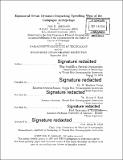| dc.contributor.advisor | W. Brechner Owens, Robert E. Todd and Kristopher B. Karnauskas. | en_US |
| dc.contributor.author | Jakoboski, Julie K.(Julie Kathryn) | en_US |
| dc.contributor.other | Joint Program in Physical Oceanography. | en_US |
| dc.contributor.other | Massachusetts Institute of Technology. Department of Earth, Atmospheric, and Planetary Sciences. | en_US |
| dc.contributor.other | Woods Hole Oceanographic Institution. | en_US |
| dc.coverage.spatial | s-ec--- | en_US |
| dc.date.accessioned | 2020-02-10T21:39:53Z | |
| dc.date.available | 2020-02-10T21:39:53Z | |
| dc.date.copyright | 2019 | en_US |
| dc.date.issued | 2019 | en_US |
| dc.identifier.uri | https://hdl.handle.net/1721.1/123737 | |
| dc.description | Thesis: Ph. D., Joint Program in Physical Oceanography (Massachusetts Institute of Technology, Department of Earth, Atmospheric, and Planetary Sciences; and the Woods Hole Oceanographic Institution), 2019 | en_US |
| dc.description | Cataloged from PDF version of thesis. | en_US |
| dc.description | Includes bibliographical references (pages 131-137). | en_US |
| dc.description.abstract | The Galápagos Cold Pool (GCP) is a region of anomalously cold sea surface temperature (SST) just west of the Galápagos Archipelago. Modeling studies have shown that the GCP is maintained by wind- and current-driven upwelling. The Galápagos Archipelago lies on the equator, in the path of the Pacific Equatorial Undercurrent (EUC) as it flows eastward across the Pacific at the depth of the thermocline. It is hypothesized that the EUC upwells into the GCP as it reaches the topographical barrier of the Galápagos Archipelago. The path of the EUC in the vicinity of the archipelago is not well understood. The 'Repeat Observations by Gliders in the Equatorial Region' (ROGER) program deployed a fleet of Spray autonomous underwater gliders in the region just west of the Galápagos Archipelago from 2013 - 2016 with the goal of continuously occupying three transects that form a closed area, with the archipelago as the eastern boundary. | en_US |
| dc.description.abstract | Gliders obtained subsurface measurements of temperature, salinity, and velocity with unprecedented temporal and spatial resolution. These measurements are used to observe the path of the EUC as it bifurcates into a north and south branch around the Galápagos Archipelago. Net horizontal transport into the volume defined by the closed area formed by the glider transects is used to estimate an average vertical velocity profile in the region of the GCP, indicating upwelling in the upper 300 m. The bifurcation latitude of the EUC, estimated to be approximately 0.4°S from volume transport as a function of salinity, is coincident with the meridional center of the archipelago, suggesting the bifurcation latitude is topographically controlled. Ertel potential vorticity and a Bernoulli function are qualitatively conserved, supporting an inertial model of the EUC. | en_US |
| dc.description.abstract | Average spectral variance from Argo profiling float observations is used to show that tropical instability waves propagate with frequency and wavelength consistent with linearized, equatorial [beta]-plane model results and may impact the GCP, according to their vertical structure. | en_US |
| dc.description.statementofresponsibility | by Julie K. Jakoboski. | en_US |
| dc.format.extent | 137 pages | en_US |
| dc.language.iso | eng | en_US |
| dc.publisher | Massachusetts Institute of Technology | en_US |
| dc.rights | MIT theses are protected by copyright. They may be viewed, downloaded, or printed from this source but further reproduction or distribution in any format is prohibited without written permission. | en_US |
| dc.rights.uri | http://dspace.mit.edu/handle/1721.1/7582 | en_US |
| dc.subject | Joint Program in Physical Oceanography. | en_US |
| dc.subject | Earth, Atmospheric, and Planetary Sciences. | en_US |
| dc.subject | Woods Hole Oceanographic Institution. | en_US |
| dc.subject.lcsh | Galapagos. | en_US |
| dc.subject.lcsh | Ocean temperature. | en_US |
| dc.subject.lcsh | Hydrography. | en_US |
| dc.subject.lcsh | Oceanography. | en_US |
| dc.title | Equatorial ocean dynamics impacting upwelling west of the Galápagos Archipelago | en_US |
| dc.type | Thesis | en_US |
| dc.description.degree | Ph. D. | en_US |
| dc.contributor.department | Joint Program in Physical Oceanography | en_US |
| dc.contributor.department | Massachusetts Institute of Technology. Department of Earth, Atmospheric, and Planetary Sciences | en_US |
| dc.contributor.department | Woods Hole Oceanographic Institution | en_US |
| dc.identifier.oclc | 1138886999 | en_US |
| dc.description.collection | Ph.D. Joint Program in Physical Oceanography (Massachusetts Institute of Technology, Department of Earth, Atmospheric, and Planetary Sciences; and the Woods Hole Oceanographic Institution) | en_US |
| dspace.imported | 2020-02-10T21:39:52Z | en_US |
| mit.thesis.degree | Doctoral | en_US |
| mit.thesis.department | EAPS | en_US |
